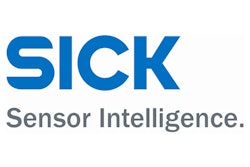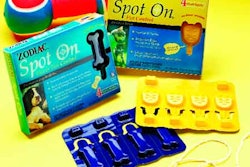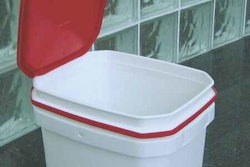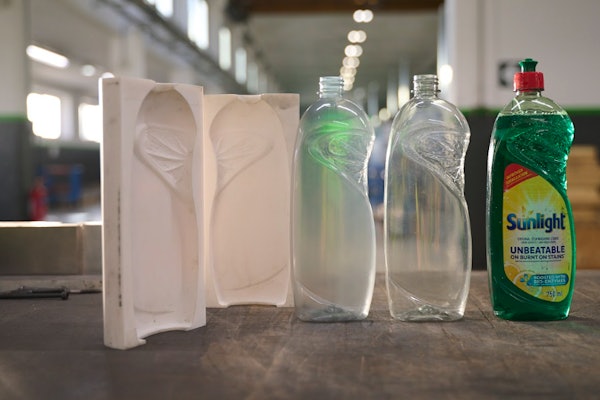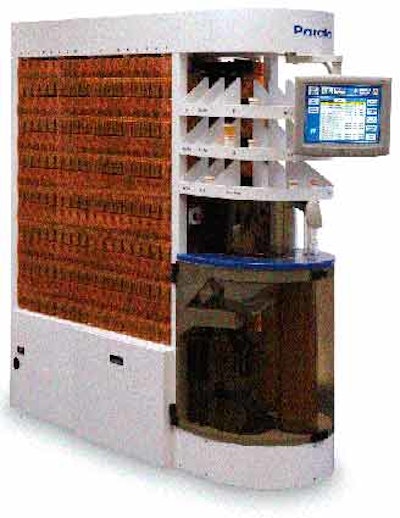
In Chaffee, MO, Medicap Pharmacy fills an average of 275 prescriptions during the nine hours it’s open during the day. But now it’s capable of filling 500 “scripts” a day without adding personnel. Pharmacists and technicians can also pay more attention to customers and provide them with better service. And customers receive prescriptions in a child-resistant, senior-friendly package that’s easy to open and reclose.
These benefits come courtesy of O-I Prescription Products’(www.o-i.com) 1-Clic® prescription package and Parata’s (www.parata.com) RDS (robotic dispensing system). The 1-Clic package consists of an amber-colored polypropylene bottle (also called a vial) and a white high-density polyethylene closure. O-I injection molds both components.
The RDS counts tablets, fills them into bottles, prints and applies a label, and applies the 1-Clic closure. The RDS and 1-Clic were added last November. Before that, Medicap Pharmacy technicians manually counted tablets and filled them into standard bottles before capping them by hand and applying labels to the bottles.
Medicap Pharmacy is owned by Kevin Teegarden and his mother. It operates as an independently owned franchisee of St. Louis-based Medicine Shoppe Intl., which owns some 1겨 Medicap Pharmacies.
Pack pairs with machinery
Teegarden explains that Medicap replaced its more standard bottles and caps with O-I’s 1-Clic system primarily because it worked best with the Parata system. He says that what differentiates the Parata machines from similar pharmacy dispensing equipment is that it also applies a cap to the bottle.
“Because the Parata machine caps the vial, it has to have a [closure] with very close tolerances. Through Parata’s years of R&D, it found the O-I vial had closer standards than anything else. They had far fewer problems with their capping mechanism, so they decided on the O-I bottlesfor use in their system.”
Automated dispensing equipment was purchased, he says, because “we reached the point where we couldn’t add any more technicians due to limited workspace.” The pharmacy measures between 500 and 600 sq’, and that includes all the shelving that holds drugs. That doesn’t leave much room for personnel. The RDS has a 12-sq’ footprint, measuring 26”Wx72”Lx77”H.
“We were working everybody as hard as we could. Normally I have three techs and two pharmacists on the counter and also a check-out clerk,” says Teegarden. “We employ nine people in total, seven of whom are full-time.”
To handle daily orders more efficiently, and to be ready to accommodate more scripts in the future, Medicap sought a more automated process. After researching its equipment options, the pharmacy selected the Parata RDS. “What makes the Parata robotic dispensing system different from other automated pharmaceutical filling systems is that it applies a cap,” says Teegarden.
Prescription pack benefits
Teegarden notes, “We started off using the 1-Clic out of necessity, but I wish I would have gone to it years ago. With most of the prescription bottles, you have to push down on the cap and turn it to get past the child-resistant portion of it. 1-Clic has a tab that you push down with your thumb and unscrew the cap. I don’t think it takes a half a turn to unscrew the cap. It is so much easier for the elderly than other vials and caps.”
Asked about the price of the new bottles and caps, Teegarden says, “I think if you compared list price to list price, they would be more expensive. But through our Medicap franchise organization Medicine Shoppe International, and through the contracts that they have with O-I, they’re no more expensive and may even be a few pennies less than the others because we buy in larger quantities.” With its 1겨 pharmacies, Medicine Shoppe International delivers that buying power. Teegarden says the 1-Clic is the endorsed product line for Medicine Shoppe International. “Before, we were buying as an individual store.”
Another benefit, Teegarden says, is that the one-piece cap is reversible, so a patient can turn it over and screw the closure into the bottle if he or she prefers not to have the child-resistant feature. The cap can then be pulled back out.
Storage cells
Teegarden explains that the RDS is used for about 50 to 55% of the Chaffee pharmacy’s prescriptions. That’s virtually all its solid-dose products. The rest of the scripts either contain liquids or are sold in blister packs.
The pharmacy uses a software system that communicates with the RDS through a local area network. A technician types in the prescription information and enters it. Each prescription has a National Drug Code (NDC) number, which is a unique product identifier for human drugs.
Medicap receives solid-dose drugs in bulk quantities, in bottles from manufacturers. Medicap workers dispense tablets from a bottle into one of the Parata machine’s 252 individual “cells.” When the Parata recognizes the NDC number for the drug from the information entered by the Medicap worker, it triggers the fill process on the Parata.
Teegarden explains that these cells are located along the sides of the Parata machine. “Each of the 252 cells can be configured to hold whatever we want. We do have thousands of medications, but in our store we calculated it down to 225 to 230 drugs that we use most often.” To do that, the pharmacy studied prescriptions during a 45-day period. They decided that any prescription ordered more than eight times in those 45 days would be filled into the machine.
He says the cells are covered and are maintained to meet Food and Drug Administration standards for medication storage. “Plus, it’s not like they’re sitting there a long period of time,” he notes. “The product in this machine moves quite rapidly.” Pill sizes vary so a cell could hold about 2ꯠ small tablets, while a cell might accommodate 100 larger pills. Teegarden estimates that each cell measures 3”Wx8”Hx9”D.
The robotic process
Technicians gently dump pills from manufacturer bottles into these cells. The cell has a bar code on it. Information for each bar code is maintained in the RDS’s computer. “To fill a cell, you scan the bar code on it, scan the code on the stock bottle, and the computer tells you whether or not it matches,” explains Teegarden. “If it does, you instructthe computer how many pills you’re adding to the cell. There’s still the human factor involved, so it’s not impossible, but it’s virtually impossible to put the wrong pill in a cell because everything is tracked, including the lot number and expiration date.”
Describing the process, Teegarden says, “Picture an object about two-feet-wide by seven-feet-long. The center of the machine is open, and that’s where the robotic arm is. You’ve got this robotic arm that can go up and grab the pill vial or bottle from the machine. It pulls an empty one out of a storage area where the O-I vials are stacked vertically in carousels. It releases a bottle that the robotic arm picks up, taking it to the proper cell. Air pressure blows the pills out of the cell and into the bottle. An electronic eye counts pills as they go past. Once the right quantity is reached, the process stops. The robotic arm takes the bottle over to the capping machine.”
A printer built into the Parata prints the pressure-sensitive thermal labels. Information includes state of Missouri requirements such as patient name, doctor name, name of the prescription, usage directions, NDC number, etc. The robot applies the label to the bottle and places it into the appropriate alphabetical slot, based on the patient’s last name. It’s then ready for a clerk or technician to give to the patient when he or she picks it up at the pharmacy counter.
Teegarden points out that technicians can perform any task related to filling the prescription, but the pharmacist is required to counsel the patient.
RDS benefits
Among the many benefits Medicap has gained since the Parata RDS was installed, says Teegarden, are these:
•Better space utilization. “With all our techs and pharmacists, it gets snug in our pharmacy. The Parata takes up less square footage than all the other systems out there.”
•Takes pressure off employees. “That was one of the goals of adding this system, and that definitely did happen. In late December, I had one woman go out on maternity leave, and another technician quit, so that left us down two techs. Everybody had to step up and work a little harder, but thanks to the robot, it made everybody else’s load light enough that we could handle it. Our people definitely appreciate this system. It’s made their jobs easier.”
•Improves customer service. “We were able to free up people to do other things that we hadn’t been able to accomplish, things like having techs call customers and do refill reminders. We were able to spend more time with customers. One of the things we didn’t foresee was when Medicare part D kicked in on January 1. While our government tries to act like everything went pretty smooth with it, it really was a nightmare. The pharmacy benefit managers that control the plans were not ready for it. It would take hours and hours of telephone calls to get medications covered, or to get somebody’s ID number straightened out. We spent many hours on the telephone during January. That overloaded us at this store. The thing we didn’t realize at that time was how much the Parata was going to help out.”
•Boosts efficiency. “The first day we put it into full production, it did 60 percent of the medications that day. It normally takes a technician one to three minutes to get a prescription ready. He or she has to get the pills from the manufacturer’s bottle, count them, prepare a label, and close it, then put the bottle away. The Parata does it in normally less than 20 seconds, usually in about 13 to 15 seconds.”
•Easy to use and maintain. “Everybody can operate the system. We have a ‘SuperTech,’ and it’s her main responsibility to take care of the machine. Very little maintenance is required. You have dusty tablets where you have to clean the cells that hold the tablets. The cell has a little electric eye in it that actually counts, which you clean by blowing off with air.”
What about return on investment?
Teegarden says the machine’s retail starting price is $190ꯠ, acknowledging that it’s a substantial investment. “The main justification,” he says, “is if you look at the machine like an employee. We did not want to drop employees when we added the RDS. We wanted it to allow us to handle a much larger workload with the same number of employees that we have.”
He estimates that the robotic system costs around $12 an hour to run, “and it doesn’t call in sick, it doesn’t gripe, and it doesn’t need a lunch break. We could easily go up to 500 scripts per day without adding anypersonnel.”
Looking towards the future, Teegarden makes this projection: “If we didn’t have the Parata system, getting to 500 prescriptions a day would require two more techs and one more pharmacist. In our area, that’s at least $50- to $60ꯠ-a-year for a technician; $100ꯠ-plus for a pharmacist. So now we’re prepared more for the future.”
Even some of Medicap Pharmacy’s customers have commented on the new machine. Teegarden explains, “It’s in view of customers. We have had customers comment whenever they see it operating about the accuracy and time savings it must give us.
“One of the things the Parata did,” he explains, “and this is a problem for every pharmacy, and for everyone I’ve ever had count pills. You get [in the habit of] counting 30 pills, then all of a sudden you get a prescription for 60 or 90 pills. For some reason you still count 30. Maybe you get disrupted and lose your count. Invariably, you have that customer that calls back and says, ‘I was supposed to get 60 pills and I only got 30 of them.’ We know that happens, but it doesn’t happen with the Parata.”
